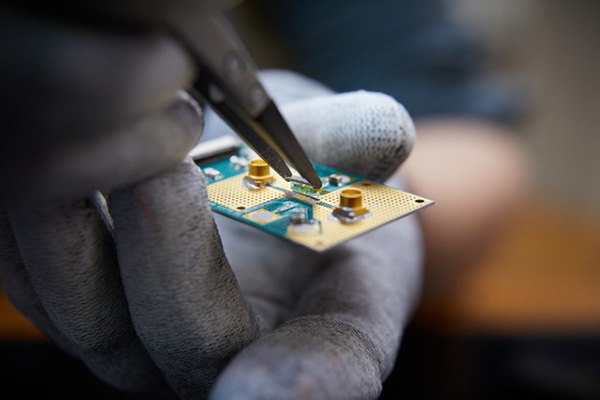New breakthrough in quantum computing: reseachers achieve a semiconductor qubit in a superconducting circuit
A study involving ICMM-CSIC demonstrates a system with great potential for new quantum computer prototypes. It is the first time that these hybrid qubits have been demonstrated in a controlled manner using a quantum dot system.

An international research effort involving the Institute of Materials Sciences of Madrid (ICMM), CSIC, has achieved a new hybrid architecture of quantum bits (qubits) using semiconductors and superconductors, which is considered a crucial step in the advancement of quantum computing as it combines the benefits of both superconducting and semiconductor materials.
This is the first time that these systems have been achieved in a controlled manner using a quantum dot system. The research has just been published in the journal Nature Physics.
Current quantum computing faces a significant challenge: demonstrating a fault-tolerant quantum computer (known as quantum decoherence). One of the possible solutions is error correction through massive scaling, requiring tens of thousands of qubits at least. However, the most advanced quantum computers today, based on superconducting circuits developed by Google or IBM, are still far from achieving this goal. One possible solution could be to use semiconductors to achieve this scaling since they utilize circuits similar to traditional electronics but are still less advanced than superconductors.
In response to this, there are several lines of research, and one is based on hybrid superconductor-semiconductor systems. "These hybrid architectures aim to design qubits that help us with scaling using the extensive knowledge we have in semiconductor materials and apply them to superconducting circuits," explains Ramón Aguado, a researcher at the Institute of Materials Science in Madrid (ICMM), CSIC, and one of the study's authors.
This work utilizes a nanostructure in which a semiconductor quantum dot defined by electrostatic gates is coupled to two superconductors. Aguado, whose theoretical analyses support the conclusions of the experimental study, explains that the great advantage of this hybrid system is the ability to modify the flow of supercurrents in a circuit containing a semiconductor qubit (conventional superconducting qubits are based on an effect where current can flow without dissipation, known as supercurrents, between two superconducting electrodes).
"This work is the result of a fruitful collaboration, highlighting the experiments conducted by Marta Pita-Vidal, a Spanish researcher pursuing her Ph.D. in Delft. With these results, we demonstrate the best of both worlds: we utilize all the capabilities of semiconductor quantum dots that allow us to isolate an individual spin (the qubit) and couple it to the rest of the superconducting circuit to modify its supercurrents. We call this new design a 'superconducting spin qubit'," explains Aguado. "We have achieved a system that behaves like an artificial atom, possessing a discrete spectrum of quantum levels that we can externally modify."
With this concept, they have also achieved "exquisite control over the physical regime of the system: in a conventional superconductor, all electrons become coupled in the state of minimum energy, forming Cooper pairs. In our system, the quantum dot allows us to obtain unpaired electrons that provide the degree of spin freedom." In fact, they can tune the qubits to be of one type or another according to their will or to present a hybrid state, "a hybrid quantum superposition of being a spin qubit or a superconductor." This "opens up a wide range of possibilities that we are exploring to propose new qubit architectures," emphasizes the researcher.
The research was carried out in collaboration with the QuTech and Kavli Institute of Nanoscience at Delft University of Technology (Netherlands), the Jožef Stefan Institute and the Faculty of Mathematics and Physics at the University of Ljubljana (Slovenia), the Center for Quantum Devices, Niels Bohr Institute at the University of Copenhagen (Denmark), the Leiden Institute of Physics at Leiden University (Netherlands), and the Department of Physics and Frederick Seitz Materials Research Laboratory, at University of Illinois Urbana-Champaign (USA).
Paper info: M. Pita-Vidal, A. Bargerbos, R. Zitko, L. J. Splitthoff, L. Grünhaupt, J. J. Wesdorp, Y. Liu, L. P. Kouwenhoven, R. Aguado, B. van Heck, A. Kou, and C. Kraglund Andersen. Direct manipulation of a superconducting spin qubit strongly coupled to a transmon Qubit. Nature Physics. DOI: 10.1038/s41567-023-02071-x
-- Ángela R. Bonachera - ICMM Communication Unit --
Photo: Printed circuit board and chip used in the experiment. The qubit is defined within a region of approximately 100 nanometers fabricated inside the chip, which is shown held with tweezers. Kouwenhoven Lab/QuTech Delft.
Instituto de Ciencia de Materiales de Madrid (ICMM)
Sor Juana Ines de la Cruz, 3
Cantoblanco, 28049
Madrid, España
Telephone: (+34) 91 334 90 00
Email: @email
Communication Office: @email

Acknowledge the Severo Ochoa Centres of Excellence program through Grant CEX2024-001445-S/ financiado por MICIU/AEI / 10.13039/501100011033

Contacto | Accesibilidad | Aviso legal | Política de Cookies | Protección de datos